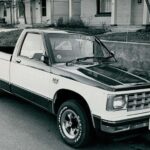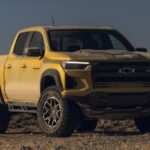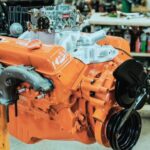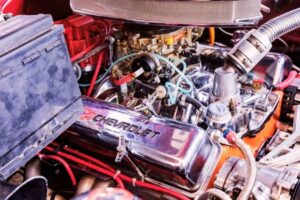The first Chevy of the 80s, the Citation, marked GM’s entry into the market for compact four-wheel-drive X-body cars. Shortly after its introduction, however, factory recalls started. The initial success of the Chevy Citation soon turned into a nightmare for the manufacturer.
When the Chevrolet Citation was introduced, one of its biggest selling points was the choice of three body versions – the most popular being the five-door hatchback.
The Citation takes pride in top-notch specs, including a 2.5-liter four-cylinder or 2.8 V6 engine with 90 or 115 horsepower. Both versions had three-speed automatic or four-speed manual transmission.
Read on to learn more about the Chevy Citation, including its soaring success and what led to its eventual failure.
About the Chevy Citation

A whole new kind of compact car – this is how the 1980 Chevy Citation was marketed. Measuring 15 feet from bumper to bumper, it fits five adults comfortably.
While it offers a station wagon’s utility, it promises exceptional performance, especially because of its surprising acceleration.
The Chevy Citation was the replacement for the Chevrolet Nova. When it was released in 1980, the company sold more than 800,000 units. It was the best-selling car in the United States at that time.
A year after, they sold over 1.2 million more Citations. The company’s aggressive marketing was one of the reasons for its huge initial success. The company also gave members of the press hand-built versions of the car.
People gave positive reviews, and soon enough, there was a clamor from the motoring public.
There were recognitions left and right, acknowledging how the Citation was an innovation in the automobile market. Motor Trend even named it The Car of the Year in 1980. Car and Driver, meanwhile, featured the car on their magazine’s cover, calling it a revolution.
Demand increased significantly, to the point that the company’s manufacturing facilities in New York and Oklahoma found it hard to keep up.
However, in the third year after its introduction, sales went down to 166,000 units. In 1985, the production was discontinued, and the Chevrolet Beretta and Corsica replaced the Citation.
In total, during the Citation’s short-lived fame from 1980 to 1985, the company sold 1,642,587 units. From rust to suspension mounts, many reasons led to the eventual downfall of the Chevy Citation.
Chevy Citation Specs and Features
- Engine: The heart of the Citation is its powerful but fuel-efficient engine. The naturally aspirated petrol engine has four cylinders, although there is also a V6 version available.
- Transmission: You can choose from two versions – three-speed automatic or four-speed manual transmission.
- Wheelbase: The wheelbase is an important consideration when buying cars as it affects the turning radius. In this model, the wheelbase is 104.9 inches.
- Steering: It has a rack and pinion steering mechanism, which is the most common in cars.
- Top Speed: The maximum speed that the Chevy Citation can reach is 87 mph or 140 kph.
- Fuel Consumption: The average fuel consumption is 43.6 mpg or 7.3 liters per 100 kilometers.
- Dimensions: Compact was the trend during the introduction of the Citation. It has a small build with dimensions of 176.7 x 68.3 x 53.9 inches.
Below is an excellent Chevrolet Citation review, including its specs and features:
Chevy Citation Design
The car market is broad, and Chevrolet addressed such by introducing three different versions of the Citation.
The most compact is a two-door notchback, also called the club coupe. Chevy immediately dropped it a year after they introduced it.
While it quickly dwindled in sales, the other two versions – a three-door and five-door hatchback, did well. The company changed the engine, and they reduced the power.
People think that Chevy Citation is a revolution due to its design and features:
1. Unitized Body Construction
Chevy’s uni-body frame of the Citation is a result of an early computerized design.
2. Full-Coil Suspension System
Designed to soak up the bumps, it guaranteed comfort. There are coil springs on each wheel to promote a smoother ride.
3. High-Energy Ignition
This is a solid-state system that ensures a quick start-up of the car.
4. Double-Wall Construction
With two layers of steel on key parts, it is thick enough to handle the impact.
5. Catalytic Converter
It ensures the smooth and responsive performance of the engine by taking care of emission control.
6. Front-Wheel Drive

Chevy Citation has a lower and flatters passenger floor. It improves traction to tackle different surfaces easily, including snow.
7. Efficient Aerodynamics
The innovative design improves fuel economy, lowers noise, and reduces wind turbulence.
How Much Did the Chevy Citation Cost?
One of the many things that made the Chevy Citation an instant hit was its price. Its price is $6,000, initially. Two years after, the cost increased to $7,000.
Despite the increase, the price was still competitive compared to other manufacturers offered at that time.
In 1983, although the price increase was only $50, sales started to sink due to dissatisfaction and bad reviews.
Changes of the Citation Through the Years
Despite the ephemeral success of the Chevy Citation, it has been through numerous transformations.
1981
A year after bringing the Citation to the global market, there was no visual change. However, Chevy discontinued the two-door coupe given the underperforming sales.
They focused on making the hatchbacks. Chevy also changed the engines to the 2.8L 135 HP engine known for its high output.
1982
Minor design revisions were introduced. Chevy replaced the egg-crate grille with a more horizontal design. Low-rolling resistance tires have found their way in the Chevy Citation, as well as a fuel injection on the 2.5L engine.
These changes improved fuel economy and drivability. The two-door version also returned.
1983
A year after, most of the changes were on the interior of the car. The traditional bench seats became obsolete and were replaced with bucket seats. The dashboard had a minor improvement too.
1984
The car was renamed Citation II. This was a futile attempt by the company to make the public think that they made significant improvements. The rebranding aimed to change the perception about the car after recalls.
The sales saw a slight increase, but it was still under 100,000 units, showing Chevrolet’s dismal performance.
1985
The Chevrolet Citation had its final production run. One of the changes introduced was the new dashboard design. It was criticized because of its vertical orientation.
Chevy replaced it with a horizontal layout, which means that users will now have more freedom to install an after-market radio.
Chevy also did fuel injection in the engine, and this resulted in reduced output. It was on June 21, 1985, when Chevy assembled the last Citation.
Introducing the Chevy Citation X-11
With cosmetic and chassis enhancements, the Chevy X-11 was marketed as an improvement to the standard Citation among a slew of other improvements. It aimed to please a more discerning audience.
The 1981 version of this car went from zero to 60 mph in only 8.5 seconds. Meanwhile, the next versions went from zero to 60 mph in 9.2 seconds.
The chassis is one of the parts that saw significant improvements in the X-11. Front and rear stabilizer bars have been added.
From the traditional steel wheels, the new Citation X-11 sported a 13-inch Rallye rim. It was popular during the muscle car era. These wheels mimicked the look of racing cars.
Chevy also improved the axle ratios and transmission gearing for better acceleration. The introduction of a taller first-gear allowed revving up to 60 mph without moving to the third gear.
A new engine was introduced in 1981. It was essentially an improved version of the 2.8L V6 and helped increase the torque output.
The Fall of the Chevy Citation
Despite the high sales in the initial year of its introduction, the Chevy Citation had not maintained its popularity. It did not take long before negative reviews made waves. Recalls have also been apparent.
One of the main criticisms against GM was that they sent a different version of the car for review. It has higher specifications than the production version, which inevitably resulted in a better performance.
Years after, the editors were surprised to learn that the commercial versions fared differently.
Rust is another major problem that contributed to the demise of the Chevy Citation. This problem was also common with other GM cars manufactured in the 1980s. All X-body GM cars have this issue. Even without leaving the showroom, rust formed.
It was indicative of a serious quality issue. When exposed to outdoor elements, such as the sun, rain, and snow, the rusting problem becomes more serious.
There was also a significant issue with the interior—a weak adhesive-bonded car’s different components. A lot of the interior parts fell off the floor, even with the slightest bump. The seat loosened easily, and the steering wheel wobbled.
Another common problem was the Iron Duke engine. This was the same engine used in the Camaro and exhibited a similar problem. It rattles as if it is on its deathbed, waiting to give up anytime soon.

The brakes had big problems too. They were faulty and fatal. It was also one of the reasons for the recall. Once the brakes are engaged, there was a tendency for the rear wheels to lock. It resulted in skidding.
This increases the chances of an accident when a driver tries to avoid something on the road.
A History of Recalls
The Chevy Citation’s bad reputation is also attributed to the recalls made throughout the years of its production. It led to negative publicity and has inevitably affected the sales of the company.
The first recall was in 1981. It was a secretive recall that aimed to fix 50,000 defective cars. There was another recall in 1983. This time, Chevy fixed 250,000 cars. Despite the recalls, quality and performance issues continued to pour.
One of the biggest blows to the company was the recall instigated by the National Highway Traffic Safety Administration in 1983. Along with the Department of Justice, GM was slapped with a $4 million lawsuit.
The latter alleged that the company was fully aware of its faulty brakes. Despite such, they continued with production and sales.
Was the Chevy Citation the Worst Car?
It is difficult and almost impossible to mention one reason why Chevy Citation failed. It is a combination of different factors. One reason is that while the components are good individually.
When combined, they are a disaster. They are from the most trusted brands, but they did not seem to work well together.
The rushed timeline is another reason for the failure. The company took advantage of the public enthusiasm. It was introduced in the market without being ripe—a lot of details needed to be ironed out before introducing the Chevy Citation.
Toyota and Nissan were doing well in the 1970s. In a bid to outrun its more established competitors, GM rushed the production of the Chevy Citation. This did not work well, as proven by the many problems experienced.
It might seem too much or too harsh, but many people call the Chevy Citation the worst car ever. Is there a basis for this? Sadly, based on the discussions earlier, there are many compelling reasons why the Citation can be tagged as the worst car ever.
It left a lot of hard-learned lessons not only to GM but to other car manufacturers as well.
For GM, the Citation represented more than just lost income. It slaughtered their reputation for the entire generation!
Conclusion – Chevy Citation
The Chevy Citation’s three body versions made it popular upon its introduction. More specifically, the five-door hatchback.
Moreover, it has top-notch specs, including a 2.5-liter four-cylinder or 2.8 V6 engine with 90 or 115 horsepower.
In sum, the Chevy Citation was a car full of promises. Nonetheless, it was introduced in a rush. The initial high sales proved hard to sustain, especially given the flaws and recalls. Nonetheless, it was a huge lesson for GM and other car companies.
A good concept is not a guarantee of success. The Chevy Citation seemed to have all the right ingredients, but in the end, it was unripe for the market.
Related reading:









![Read more about the article Chevy Colorado Reliability [How Reliable Are They?]](https://roadsumo.com/wp-content/uploads/2022/02/Chevy-Colorado-reliability-300x200.jpg)